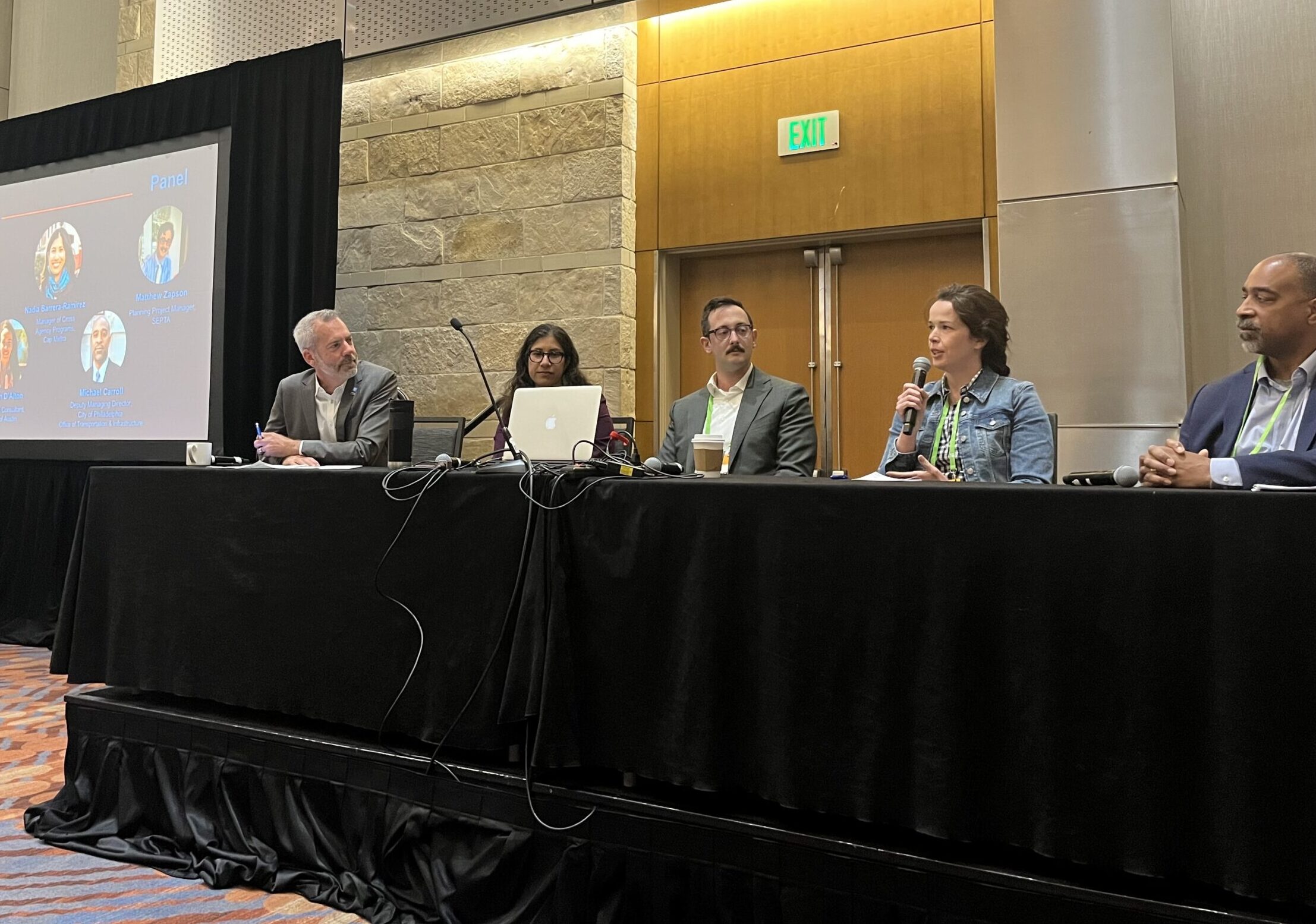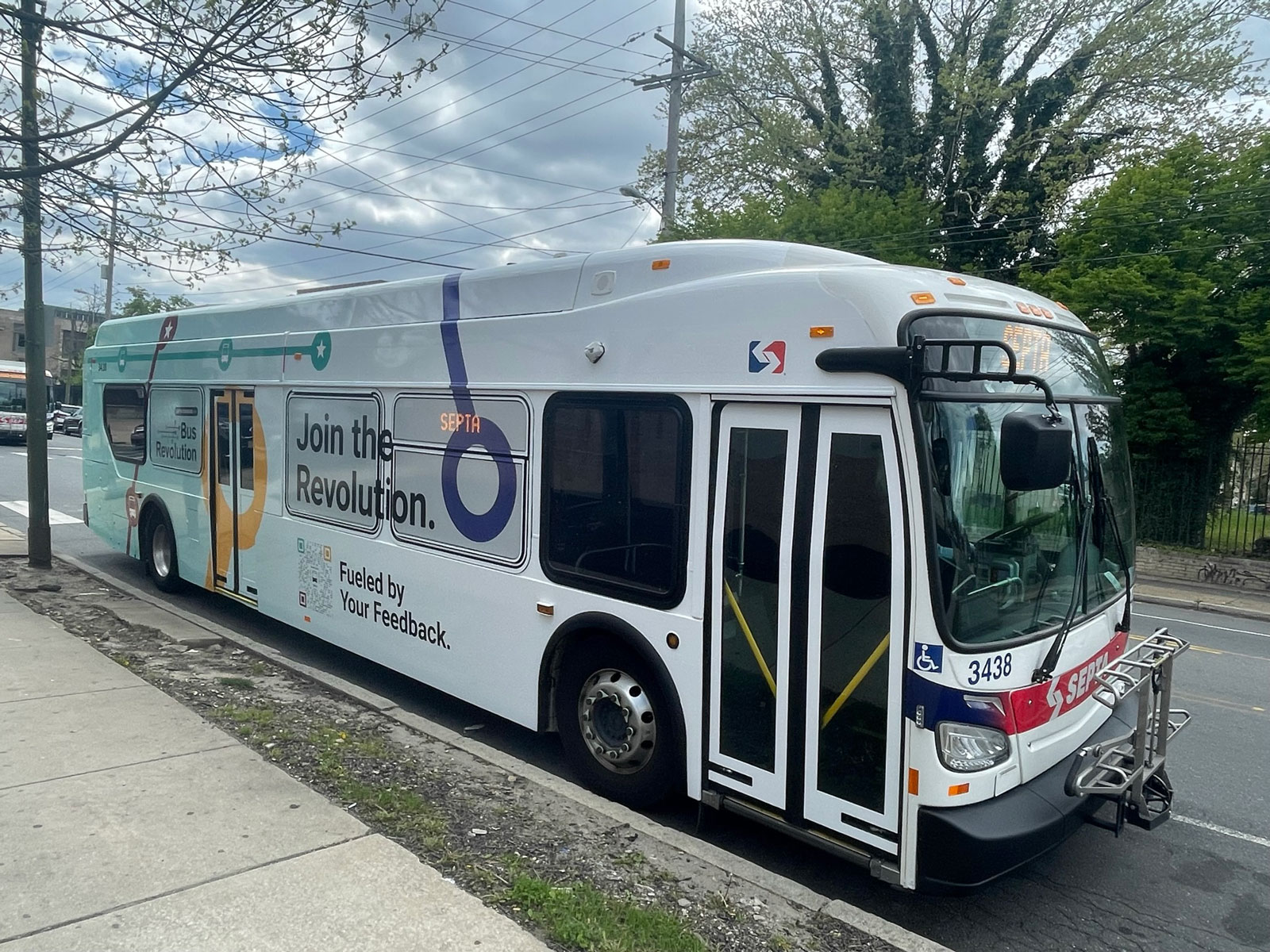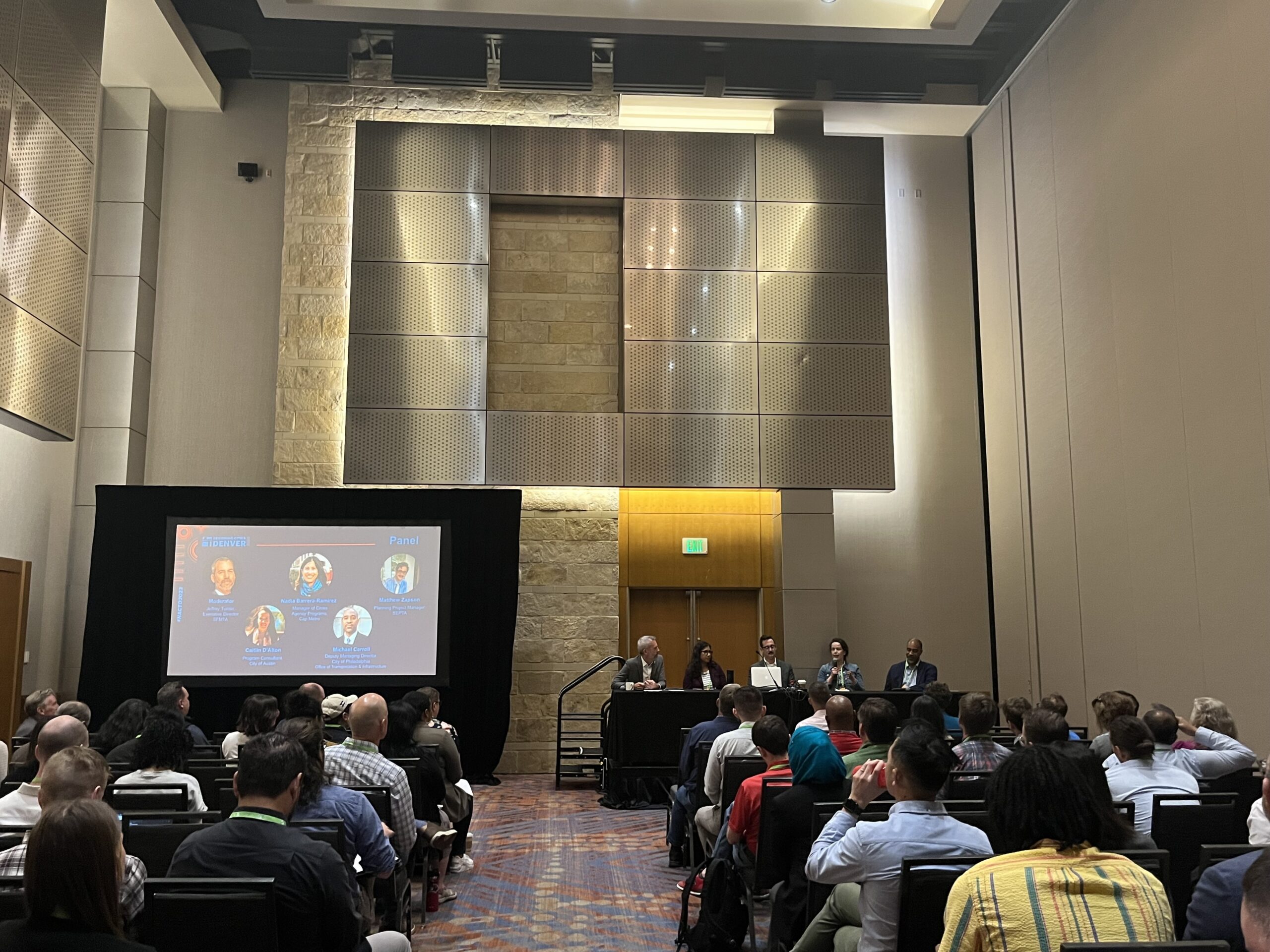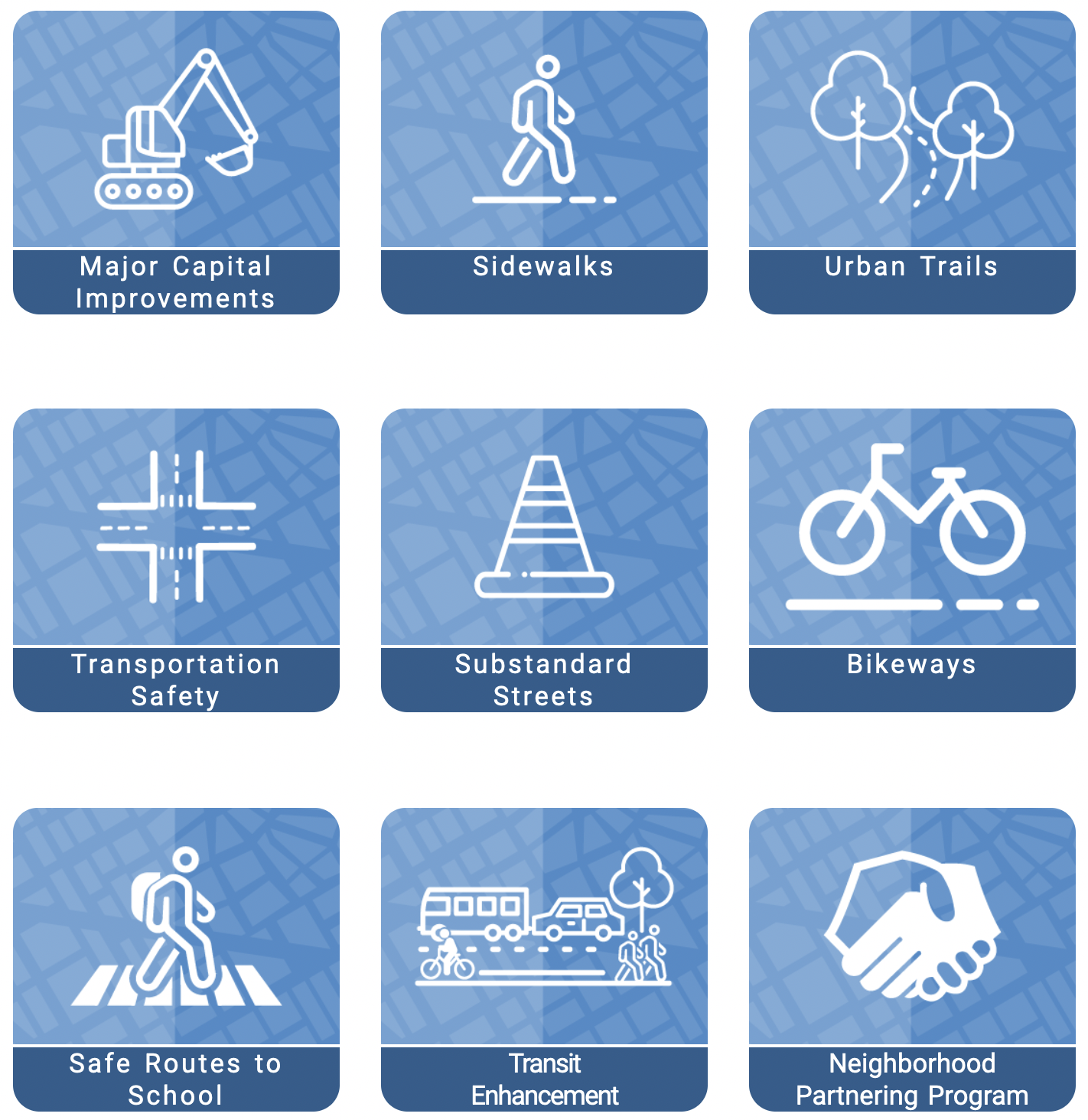“Conference Cliff Notes” is a series of short blog posts summarizing big takeaways and interesting ideas from NACTO’s 2023 Designing Cities Conference in Denver. You can read more about the conference here.

From left, Jeffrey Tumlin (moderator), Nadia Barrera-Ramirez, Matthew Zapson, Caitlin D’Alton, and Michael Carroll.
Completing bold, transformative transportation projects often requires deep collaboration and partnership across government agencies. That’s particularly true when it comes to the complex interplay of streets and public transit systems. The ability of city transportation departments and transit agencies to build supportive cross-agency relationships can play a make-or-break role in such projects.
How these agencies can successfully work together was the focus of “It Takes Two: Building Better Partnerships Between Cities & Transit Agencies,” a breakout session at #NACTO2023, where leaders from both sides of such partnerships shared tips for improving internal communications, long-range strategic planning, and on-the-ground project delivery.
Sometimes, these partnerships start with a formal agreement. The Transit First program, for example, was a cooperative agreement between SEPTA and the City of Philadelphia to improve quality of life in the city through improvements to surface transportation operations. In the decades since the agreement was signed in 1989, the formal relationship has helped facilitate various collaborative efforts, such as a 2013 move to lease a city-owned underground subway concourse to SEPTA, who would in turn maintain and make improvements to the stations. More recently, initiatives like the Bus Revolution bus network redesign and Metro Wayfinding Program have required regular cooperation between the agencies and with outside partners.

SEPTA Forward’s Bus Revolution project is focused on delivering an easier to use, more convenient and more reliable bus network informed by its riders.
“The City is subject to different political constraints than we are, which means we have to consider what’s happening at both the state-level as well as what’s happening citywide,” panelist Matthew Zapson, a Planning Project Manager at SEPTA, told attendees. “Philadelphians will butt heads sometimes, but we have common goals and can usually work it out.”
SEPTA’s independence as a state authority can simultaneously be a constraint as well as a useful justification for supplementing state and federal dollars with local revenue, said Michael Carroll, Deputy Managing Director of Philadelphia’s Office of Transportation and Infrastructure. Since SEPTA is such an important part of the city’s transportation system, the city is willing to support the agency with additional local revenue–it isn’t an “us versus them” conversation. That approach enables the agencies to move forward with initiatives that help increase ridership, like commuter benefits programs, and then enforce them with city ordinances.
“We’re focused on mobility and accessibility for modes beyond transit,” Carroll said. “However, SEPTA is an integral part of the city’s transportation network. We have an appreciation for all ways of getting around and are committed to building an integrated mobility network that works with the transit system.”
Leveraging support from the city administration on strategic planning efforts can also help convince transit agency executives. Sometimes, pitching an idea as being from the city or managing director’s office is more persuasive than when it comes directly from transit agency staff. This type of strategic partnership isn’t just the result of formal agreements like the Transit First program; it’s also the product of building personal relationships between agency staff to build mutual trust. Staff from both the City and SEPTA meet regularly through project subcommittees, but they also connect at professional events like the NACTO conference, and at joint social gatherings.
“You have to start somewhere,” Carroll told attendees. “That can be in small ways like one-on-one conversations outside of work, and then bring them back into the office over time. This is true whether you’re new to the team, or have been there awhile and need to start fresh with someone. Every day is a new beginning; there is always time to move forward wherever you’re at in your relationship.”

Such informal conversations can also be the starting point for broader partnership. The City of Austin and CapMetro began building their relationship in 2015 through bi-monthly meetings–with tacos!–to discuss interagency priorities and work through issues. In 2018, the agencies formalized their partnership through the development of an interlocal agreement in which CapMetro reimburses the City up to $1 million a year to design and build out infrastructure for faster and more reliable bus service.
Much like in Philadelphia, panelists Caitlin D’Alton (Program Consultant with the City of Austin’s Transit Enhancement Program) and Nadia Barrera-Ramirez (Manager of Cross Agency Programs Transit and Mobility at CapMetro) have found that building personal relationships between agency staff made their working relationships more successful. Both Barrera-Ramirez and D’Alton have worked for both the City and transit agency at different points in their careers, which has helped each better understand the challenges or constraints the other is facing, and how to best communicate across agency silos.
“Opposing perspectives from each agency can be frustrating to navigate,” Barrera-Ramirez told attendees. “Sometimes we find ourselves asking: do you care about us? But you have to realize that the City has a wide range of priorities to consider, and those have to be balanced with needs from the transit agency.”
Austin and CapMetro have found it easier to work around political constraints and differences when they share a mutual goal, along with a strategic plan or policy to leverage for more funding. In 2020, for example, the City put forward a bond referendum for safety and active transportation improvements, which included an influx of funding for transit projects. In the leadup to the vote, the City needed to not only demonstrate to the public what it could accomplish with the funding, but also prove that its vision for the money was feasible. City leaders identified specific project proposals that the tax revenue from the referendum could fund; once the referendum was approved by voters, City staff got to work with CapMetro on developing and implementing those improvements.

In November 2020, Austin voters approved $460 million for transportation infrastructure including sidewalks, transportation-related bikeways, urban trails, transportation safety projects (Vision Zero), safe routes to school and substandard streets.
“Building trust and mutual knowledge takes time, and you have to invest in these relationships for the long run,” D’Alton said. “Having a diverse project team and gathering everyone in the same room helps a lot, as well as having executive support at both agencies to keep the communication lines open. Partnerships like this truly are a ‘marriage.’ They aren’t just based on data or technical knowledge, but on personal relationships between individuals.”
Of course, successful partnerships between large agencies don’t always come easy. The successes in Philadelphia and Austin are the result of long, slow engagement over time. Even in the most successful partnerships, there will be bumps in the road, Barrera-Ramirez reminded attendees. But those bumps are learning opportunities, not failures.
“Be ready to fail!” Barrera-Ramirez concluded. “It’s going to happen, and you have to be able to work through it and move forward together.”